
|
|
|
|
 |
|
Home Site Search Contact Us Subscribe
|
|
|
|
Stately Restoration: New York State Capitol Assembly Chamber Floor by Françoise Bollack Architects
Albany, New York: A treasure trove of 19th century design is restored and adapted for a 21st century democracy. by ArchNewsNow April 4, 2004 The New York State Capitol in Albany, built 1867–1899, contains a
rich history of turn-of-the-century design. The legislative (third) floor
includes two
of Leopold Eidlitz’s masterful Gothic Revival interiors: the Assembly Chamber
and the Assembly Parlor. Following a major fire in
1911, the corner Committee Room, the Speaker’s Conference Room, and the
corridor in the western section of the third floor were redesigned with a Beaux
Arts architectural treatment. Over the years, double height volumes had been in-filled
with offices, storage, and mechanical equipment, and original surfaces and decorative finishes had been concealed or destroyed. Motivated
by a desire to provide universal access to the New York State Assembly Chamber,
the NYS Assembly commissioned New York City-based Françoise Bollack Architects
to renovate and restore the Chamber and related third floor public spaces. The
combination of styles and existing conditions presented numerous challenges in
the restoration of ceremonial spaces as well as in the design of new offices, meeting
rooms, and bathrooms. The initial
phases of restoration work focused on the Assembly Chamber, introducing
universal access and allowing the lobbies to again function as screens and
vestibules. The Chamber could then resume its position as the “People’s Chamber”
– a legislative room that invites public interaction and embodies democratic
values. New ramps for the East Vestibule and West Lobby are
sympathetic stylistically to the existing historic design. Ramps were also added
to the restored Rostrum as well as to the Chamber. The now accessible Viewing
Galleries, with new stepped seating, were reopened with their original vaults
carefully restored to their original polychromatic splendor. The challenge in the Eidlitz-designed Beaux Arts Speaker’s
Conference Room was to restore the perimeter conditions of the room, installing
the historic tall windows and low marble HVAC enclosures that tie into the
restored marble border and base. This work, as well as the new perimeter
lighting, makes the meeting room much brighter and offers commanding views of
the city. For the restoration of the Gothic Revival Assembly Parlor, also
designed by Eidlitz, extensive research was conducted into the original colors
and design of the room. The original stencil patterns were recreated using two
1880s black-and-white photographs, and the bead board-paneled, coffered ceiling
was restored. Introducing adequate lighting, electrical/data, and HVAC to the
Parlor was a complex endeavor. Additional supply and return air is provided
along the west wall by linear slots cut through the 18-inch-thick brick wall
requiring intricate and coordinated shoring. The air moves through delicate new
grilles that match the patterns of the historic stencil bands. In addition to the restoration work, new design elements
were incorporated when the program required new spaces, primarily office and
conference rooms. As a result of the new universal access from the West
Corridor to the West Lobby, a major reconfiguration of this area was necessary.
The new program called for a reception area and a conference room for the
Speaker. Large transparent glass walls and wood surfaces were added to create a
light yet warm office environment, allowing the historic building to coexist with
the new program elements. One glass wall placed on the diagonal creates two
rooms easy circulation from the reception area to the Speaker’s Office. In another office, Room 343, originally part of the main
vaulted corridor, the historic plaster vault and marble walls, which had been
concealed, were restored. This room continues as a private office, but the
introduction of two new high glass walls reintroduces daylight to the public circulation
area, while door-height wood paneling provides privacy and adds warmth to the
office. In the Majority Leader's Office (Room 341), a partition separating the
reception area (Room 341a) was removed – the high ornate plaster ceiling now
continues through the spaces unobstructed. A new lower glass ceiling in Room
341a adds privacy and light – and a view to the historic ceiling above. This
extensive architectural work completes the fourth phase of the overall master
plan for the restoration of the New York State Capitol, and will both preserve
and reinvigorate this venerable historic public building. The project was
presented with the 2003 Award of Merit from the AIA
New York State. Project credits: Owner/Client: New York State Assembly Client Team: Sheldon Silver, Speaker; Randall Bluth,
Commissioner, Legislative Bill Drafting Commission, and Project Director for
Phases I, II, III; Joseph O’ Brien, Director of Operations and Project Director
for Phase IV; Paul Fote, Project Manager; Andrea Lazarski, Restoration
Coordinator, NYS Commission on the Restoration of the Capitol Architect: Françoise Bollack Architects, New York City
Project Team: Françoise Bollack,
AIA (Principal-in-Charge); Phase IV: Laura Heim, AIA, Fernando Villa, Assoc.
AIA; Phase I, II, III: Sarah Diaz, Jeff Atwood, Jeff Dembowski. Structural Engineer: Robert Silman Associates,
New York City Mechanical Engineer (MEP): Landmark Facilities Group, East
Norwalk, CT Glass Consultant: Dewhurst Macfarlane and Partners, New York City Lighting Consultant: Kugler Tillotson
Associates, New York City Photography: Seth
Boyd; Gary Gold Construction Contractor (Phase IV): Ganem
Contracting Corporation, Clifton Park, NY Françoise Bollack Architects is a New York City-based architectural firm founded in 1981 specializing
in new design in historic settings and historic preservation, as well as
retail, office, institutional, and residential design. The renovation of and addition to the Lesbian, Gay, Bisexual and
Transgender Community Center in New York City earned the firm four awards.
Other projects include: Chesterwood
Visitor Center, Stockbridge, Massachusetts; Snug Harbor Cultural Center, Staten
Island, NY; P.C.F.G. New York Headquarters; and several boutiques and
showrooms. Françoise
Bollack, AIA, is an adjunct professor of design in the Historic Preservation
Department of the Graduate School of Architecture, Planning and Preservation of
Columbia University where she directs the Design Principles for Preservation
studio. |
(click on pictures to enlarge) 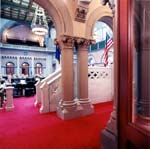 (Gary Gold) New York State Assembly Chamber restored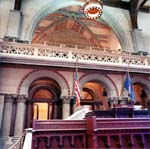 (Gary Gold) Assembly Chamber: rostrum and west gallery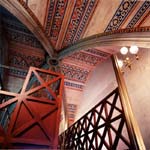 (Gary Gold) East gallery ceiling detail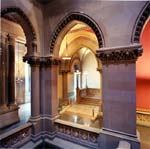 (Gary Gold) East vestibule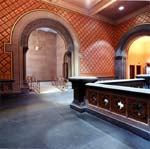 (Gary Gold) East vestibule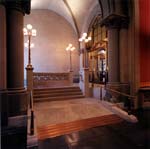 (Gary Gold) East vestibule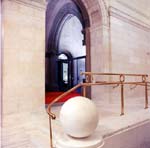 (Gary Gold) West lobby and corridor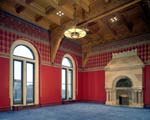 (Seth Boyd) Restored Assembly Parlor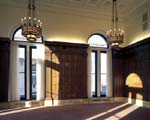 (Seth Boyd) Restored Speaker's Conference Room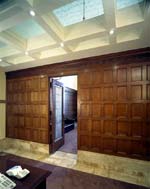 (Seth Boyd) Reception area in Majority Leader's Office: a glass ceiling adds privacy and light - and a view to the historic ceiling above.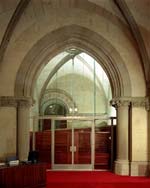 (Seth Boyd) Entrance to Room 351, a new office in the west lobby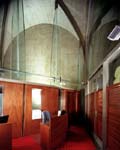 (Seth Boyd) Interior of Room 351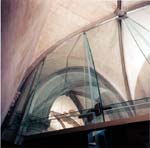 (Gary Gold) Detail of diagonal wall and glass fins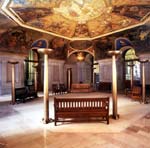 (Gary Gold) Governor's reception room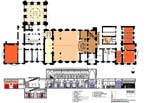 (Françoise Bollack Architects) Floorplan and section |
© 2004 ArchNewsNow.com